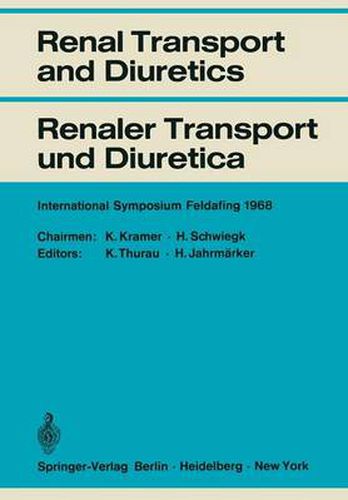Readings Newsletter
Become a Readings Member to make your shopping experience even easier.
Sign in or sign up for free!
You’re not far away from qualifying for FREE standard shipping within Australia
You’ve qualified for FREE standard shipping within Australia
The cart is loading…






This title is printed to order. This book may have been self-published. If so, we cannot guarantee the quality of the content. In the main most books will have gone through the editing process however some may not. We therefore suggest that you be aware of this before ordering this book. If in doubt check either the author or publisher’s details as we are unable to accept any returns unless they are faulty. Please contact us if you have any questions.
It is generally appreciated that large congresses are not the optimal means of facilitating communication within specialized areas of medical research. Small symposia, where scientific discussion can be confined to limited groups, have lately become successful vehicles of information transfer. However, such symposia, although eminently suited to the exploration of specific problems, often have the llherent'disadvantage of not being able to successfully address themselves to larger themes. Accordingly, the planners of this symposium have solicited the parti- cipation of internationally acclaimed investigators to consider current problems both in the physiological and clinical domains of nephrology. The observant reader will note that the variety of theoretical and experi- mental approaches used by the physiologists are reflected in the clinical studies, while the clinicians, in turn, have provided the physiologists with useful insights. The part of the symposium which attempted to correlate metabolic characteristics of kidney cells with their transport functions has proven to be particularly fruitful. For example, the presentations dealing with aldosterone, angiotensin and diuretics have offered a multi-faceted approach that was previously unavailable. The contributions of investigators from many countries and their enthusiastic participation have led to the success of this symposium. To them we wish to express our deep gratitude. We also wish to sincerely thank Dr. K. H. BEYER, Senior Vice President of Merck, Sharp & Dohme Research Laboratories, and Dr. H. F. HOFMANN, Director of Medical Research of Sharp & Dohme GmbH for their full support and their constant attention to our many requests.
$9.00 standard shipping within Australia
FREE standard shipping within Australia for orders over $100.00
Express & International shipping calculated at checkout
This title is printed to order. This book may have been self-published. If so, we cannot guarantee the quality of the content. In the main most books will have gone through the editing process however some may not. We therefore suggest that you be aware of this before ordering this book. If in doubt check either the author or publisher’s details as we are unable to accept any returns unless they are faulty. Please contact us if you have any questions.
It is generally appreciated that large congresses are not the optimal means of facilitating communication within specialized areas of medical research. Small symposia, where scientific discussion can be confined to limited groups, have lately become successful vehicles of information transfer. However, such symposia, although eminently suited to the exploration of specific problems, often have the llherent'disadvantage of not being able to successfully address themselves to larger themes. Accordingly, the planners of this symposium have solicited the parti- cipation of internationally acclaimed investigators to consider current problems both in the physiological and clinical domains of nephrology. The observant reader will note that the variety of theoretical and experi- mental approaches used by the physiologists are reflected in the clinical studies, while the clinicians, in turn, have provided the physiologists with useful insights. The part of the symposium which attempted to correlate metabolic characteristics of kidney cells with their transport functions has proven to be particularly fruitful. For example, the presentations dealing with aldosterone, angiotensin and diuretics have offered a multi-faceted approach that was previously unavailable. The contributions of investigators from many countries and their enthusiastic participation have led to the success of this symposium. To them we wish to express our deep gratitude. We also wish to sincerely thank Dr. K. H. BEYER, Senior Vice President of Merck, Sharp & Dohme Research Laboratories, and Dr. H. F. HOFMANN, Director of Medical Research of Sharp & Dohme GmbH for their full support and their constant attention to our many requests.